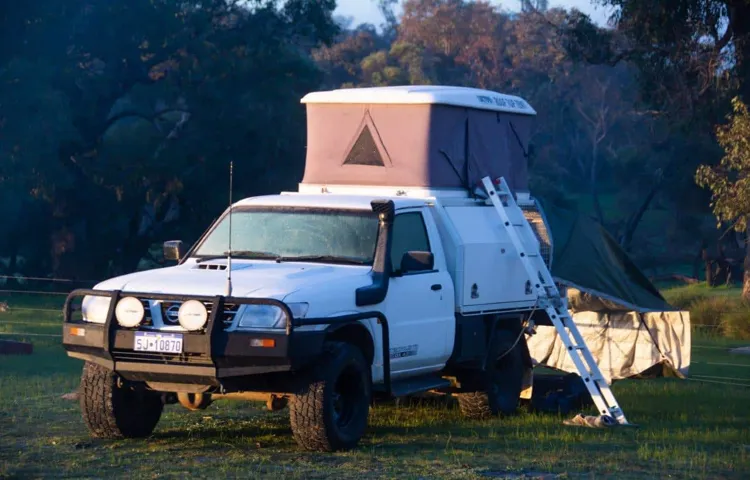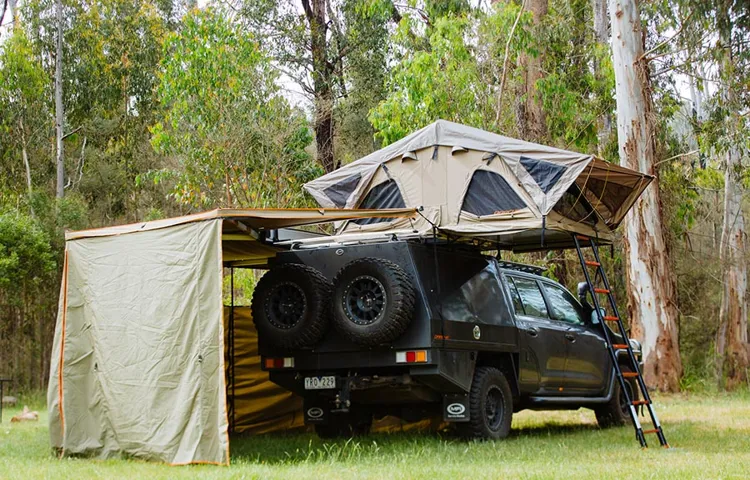Thinking about adding a roof top tent to your adventure arsenal? You’re not alone. These innovative tents have gained popularity among outdoor enthusiasts for their convenience and versatility. However, before you make a purchase, one important question might be on your mind: will a roof top tent fit in my garage? It’s a valid concern, especially if you plan on using your roof top tent for camping trips, but also want to keep it protected and out of the elements when not in use.
The dimensions of your garage and the size of your vehicle will ultimately determine whether or not a roof top tent can be stored safely and easily. Imagine pulling into your garage after a long weekend getaway, tired from hiking, fishing, or simply exploring the great outdoors. As you unload your gear and prepare to park your vehicle, you may start to wonder, “Can I fit my roof top tent in here?” The answer to this question will depend on several factors, including the height of your garage door, the clearance inside your garage, and the size of your vehicle.
Just like trying to fit a square peg into a round hole, trying to fit a roof top tent into a space that is too small can be frustrating and potentially damaging. It’s important to take accurate measurements and consider any potential obstacles that may impede the safe storage of your roof top tent. Think of your garage as a puzzle and your roof top tent as one of the pieces that needs to fit perfectly.
Will it slide seamlessly into place, or will it be a tight squeeze? You don’t want to force it or risk damaging your tent or your vehicle. In this blog post, we will explore the dimensions of roof top tents, the clearance requirements for safe garage storage, and provide tips and tricks to help you determine if a roof top tent can fit in your garage. So, before you hit the road for your next adventure, let’s find out if your garage can accommodate your roof top tent.
Table of Contents
Measurements and Dimensions
Many outdoor enthusiasts are wondering if a roof top tent would fit in their garage. Well, the answer depends on the size and dimensions of both the tent and the garage. Roof top tents come in various sizes, ranging from small enough to fit on compact cars to large enough to accommodate a family.
Similarly, garages can vary in size, with some being spacious enough to park multiple vehicles and others being smaller and more limited in space. To determine if a roof top tent will fit in your garage, you’ll need to measure the dimensions of both your tent and your garage. Measure the length, width, and height of your tent when it is closed and compare it to the available space in your garage.
Don’t forget to consider any obstacles, such as roof racks or antennas, that may affect the fit. Taking accurate measurements will give you a better idea of whether your roof top tent is compatible with your garage. So go ahead, grab a tape measure and find out if your garage can accommodate your exciting new camping accessory.
Determining the size of your garage
Determining the size of your garage can seem like a daunting task, but with the right measurements and dimensions, it can be a breeze. When deciding on the size of your garage, there are a few things to consider. First, think about what you will be using the garage for.
Will it only be used for parking your cars, or will you also need extra space for storage or a workshop? Once you have determined how you will be using the garage, it’s time to take some measurements. Start by measuring the width and length of your vehicles to ensure that they will fit comfortably in the garage. You should also take into consideration any additional space you may need for walking room or storage.
Another factor to consider is the height of your garage. If you have larger vehicles or plan on storing tall items, you will want to make sure that the garage has enough height clearance. Additionally, consider the layout of your property and any zoning regulations that may affect the size and placement of your garage.
By carefully considering these measurements and dimensions, you can ensure that your garage is the perfect size for your needs.

Measuring the dimensions of the roof top tent
roof top tent, measurements and dimensions When it comes to choosing the perfect roof top tent for your outdoor adventures, one of the most important things to consider is its measurements and dimensions. After all, you want to make sure that the tent not only fits comfortably on your vehicle’s roof, but also provides enough space for you to sleep and relax. First and foremost, you should measure the length and width of your vehicle’s roof to determine the maximum dimensions of the roof top tent that will fit.
Make sure to take into account any roof racks or attachments that may be on your vehicle, as these can affect the available space. Additionally, consider the weight capacity of your vehicle’s roof, as some tents can be quite heavy. Next, consider the height of the roof top tent.
This is especially important if you plan on parking in areas with low clearance, such as parking garages or under tree branches. Measure the distance between your vehicle’s roof and the highest point on the tent when it is fully set up to ensure that it will fit comfortably in these types of spaces. Another important dimension to consider is the sleeping capacity of the roof top tent.
Most tents are designed to comfortably fit two to three people, but there are also larger options available for bigger groups or families. Take into account the length and width of the sleeping area to ensure that it will provide enough space for a good night’s sleep. Lastly, don’t forget to consider the overall weight and packed dimensions of the roof top tent.
This is important if you plan on transporting the tent to multiple locations or if you have limited space for storage. Some tents are designed to be more compact and lightweight, making them easier to handle and transport. In conclusion, measuring the dimensions of a roof top tent is crucial when it comes to finding the perfect fit for your vehicle and ensuring a comfortable camping experience.
Consider the length, width, and height of the tent, as well as its sleeping capacity and overall weight. Taking these measurements into account will help you choose a roof top tent that is perfect for your outdoor adventures.
Comparing the measurements
“Measurements and Dimensions” When it comes to measurements and dimensions, it’s important to understand the various systems and units of measurement that exist. From the metric system to the imperial system, each has its own unique way of quantifying objects and spaces. The metric system, commonly used around the world, uses units such as centimeters, meters, and kilograms.
On the other hand, the imperial system, predominantly used in the United States, relies on inches, feet, and pounds. While both systems are widely used, they can cause confusion and inconsistencies when converting between them. For example, someone who is used to measuring with inches may struggle to visualize the same dimensions in centimeters.
This variation in measurement can lead to errors and misunderstandings, making it crucial to be aware of the different systems and their conversions. By understanding and being familiar with both systems, we can ensure accurate measurements and clear communication across different measurement practices.
Clearance and Obstacles
Are you wondering if a roof top tent will fit in your garage? Well, the answer to that question depends on a few factors. First and foremost, you need to consider the clearance of your garage. Most roof top tents have a height of around 6-8 inches when closed, so you’ll need to measure the height of your garage entrance to ensure there is enough space for the tent to fit.
Additionally, you’ll want to take into account any obstacles that may be present in your garage, such as low-hanging pipes or beams. These can limit the height of your garage entrance even further. So before investing in a roof top tent, make sure to measure the clearance of your garage and assess any potential obstacles.
With the right measurements and careful planning, you can enjoy the benefits of a roof top tent without having to worry about storage.
Checking for overhead obstructions
When it comes to moving or operating heavy equipment, one important factor to consider is the clearance and obstacles above. Checking for overhead obstructions is crucial for safety and to prevent any potential damage to the equipment or surrounding structures. Before starting any task, it’s essential to evaluate the working area and look for any potential hazards such as low-hanging branches, power lines, or ceiling beams.
These obstructions can pose a significant risk and can lead to accidents or even severe injuries if not properly addressed. To ensure clearance, it’s important to measure the height of the equipment and compare it to the available space. This will help determine if there is enough space to maneuver safely without risking any damage or accidents.
Additionally, it’s crucial to be aware of any changes in height throughout the working area. Sloping terrain or uneven surfaces can affect clearance and may require additional precautions or adjustments. In some cases, overhangs or protrusions may be present in the path of the equipment.
These obstacles can cause potential damage to the equipment or the surrounding structures. It’s essential to identify and mark these obstacles to avoid any accidents or damage during the operation. This can be done by using caution tape or signage that clearly indicates the presence of an obstruction, ensuring everyone in the area is aware and can take the necessary precautions.
Regular inspections and maintenance of the working area are also important to identify any potential hazards that may arise over time. This can include checking for loose tree branches, deteriorated roof structures, or any changes in the surrounding environment. By staying vigilant and addressing any obstacles promptly, you can ensure a safe and efficient working environment for both the operators and the equipment.
In conclusion, checking for overhead obstructions is a crucial step to ensure safety and prevent potential damage when operating heavy equipment. By evaluating the clearance and identifying any obstacles beforehand, operators can effectively plan and execute their tasks in a secure manner. Regular inspections and maintenance of the working area are also essential to address any changes or potential hazards.
Measuring the clearance height
clearance height, obstacles, measuring clearance height, vehicle clearance, overhead clearance, bridge clearance, height restrictions The clearance height is an essential factor to consider when navigating through any area, especially when driving a tall vehicle. It refers to the vertical distance between the ground and the lowest point of a structure, such as a bridge or an overhead sign. Measuring the clearance height is crucial to determine if a vehicle can safely pass underneath without causing damage or collisions.
Various obstacles can pose a challenge when it comes to clearance height. For instance, low-hanging branches, awnings, or even construction scaffolding can obstruct the path and require careful navigation. It’s important to be aware of any height restrictions in the area and determine whether your vehicle can safely pass through.
One way to measure the clearance height is by using a measuring tape or a measuring stick. Start by positioning your vehicle directly underneath the obstacle or structure you wish to measure. Then, extend the measuring tool vertically until it touches the lowest point of the obstacle.
Take note of the measurement, which will give you an accurate clearance height. Another method is to consult height restriction signs or check online resources for information on specific areas. Many bridges, tunnels, and overpasses have posted height restrictions to ensure the safety of all vehicles passing through.
It’s crucial to pay attention to these restrictions and plan your route accordingly. In addition to measuring the clearance height, it’s essential to keep in mind other factors that may affect your vehicle’s ability to pass through certain areas. Consider the size and weight of your vehicle, as well as any potential hazards that may be present.
It’s always better to be cautious and avoid potentially risky situations. In conclusion, measuring the clearance height and being aware of obstacles is vital for safely navigating through areas with height restrictions. By taking the necessary precautions and utilizing the proper tools, you can ensure that your vehicle can pass through without any issues.
Considering any obstacles
clearance, obstacles
Alternative Storage Options
If you’re considering getting a rooftop tent for your adventures, one important question to ask is whether it will fit in your garage. After all, you want to make sure you have a convenient and secure place to store your tent when you’re not using it. The answer to this question ultimately depends on the height of your garage and the dimensions of the rooftop tent you choose.
Most standard garages have enough clearance for a rooftop tent, but it’s always a good idea to measure the height of your garage and compare it to the dimensions of the tent you’re interested in. Additionally, you may need to consider any obstructions, such as roof racks or other equipment, that could affect the fit. If your garage is too low or you have other obstructions, you may need to consider alternative storage options, such as a carport or dedicated storage space.
Overall, it’s essential to plan ahead and consider the logistics of storing your rooftop tent to ensure a hassle-free experience.
Utilizing a carport or awning
alternative storage options, carport, awning Are you running out of storage space in your home? Don’t worry, there are plenty of alternative storage options available that can help you keep your belongings safe and organized. One such option is utilizing a carport or awning. These structures are not only designed to protect your vehicle from the elements but can also be used as additional storage space.
Whether you have bicycles, gardening equipment, or even outdoor furniture that needs to be stored, a carport or awning can provide the perfect solution. With its open design, you can easily access your items whenever you need them, without the hassle of going through a cramped storage unit or searching through a cluttered garage. Plus, these structures are often made from durable materials like steel or aluminum, ensuring that your belongings will stay protected from the elements.
So why not make the most of your outdoor space and turn your carport or awning into an alternative storage option?
Renting a storage unit
storage options, alternative storage options, renting a storage unit, storage alternatives, self-storage alternatives If you’re in need of extra storage space but don’t want to commit to renting a storage unit, there are alternative options to consider. One option is to utilize the storage space you already have in your home. Look for unused corners, closets, or the space under your bed where you can organize and store items.
Another alternative is to rent a portable storage container. These containers can be delivered to your location, allowing you to easily pack and store your belongings without the need for transportation. Additionally, you can also explore the option of renting space in a friend or family member’s basement or garage.
This not only provides a cost-effective storage solution but can also allow you to support and help each other out. Finally, you may want to consider decluttering and downsizing your belongings. By getting rid of items you no longer need or use, you can free up valuable space in your home without the need for external storage.
Ultimately, there are plenty of alternative storage options to consider before committing to renting a storage unit, so be sure to explore all possibilities before making a decision.
Finding a nearby parking space
Alternative storage options can be a lifesaver when you’re running out of space for all your belongings. Fortunately, there are several options available that can help you find the extra space you need without breaking the bank. Consider renting a self-storage unit, which allows you to store your items in a secure and monitored facility.
These units come in various sizes, giving you the flexibility to choose the one that best suits your needs. Another alternative is to utilize the services of a portable storage company. These companies deliver a storage container right to your doorstep, allowing you to pack it at your own pace.
Once you’re finished, they will pick it up and store it for you. This is a convenient option for those who need temporary storage or who prefer to have their belongings packed up and stored for them. Whether you’re downsizing, moving, or simply need more space, these alternative storage options can provide the solution you’re looking for.
So don’t let the clutter overwhelm you. Explore these options and find the storage solution that fits your needs.
Conclusion
Well, my friend, ponder no more! For the question that has plagued many adventurers’ minds has finally been answered. Will a rooftop tent fit in your garage? Ah, the suspense! But fear not, I come bearing good news. With the finesse of a circus contortionist and the precision of an Olympic archer, a rooftop tent can indeed fit snugly into the confines of your garage.
It’s like a majestic puzzle piece, crafted by the gods of adventure themselves, to perfectly slot into your own personal storage haven. Picture this: a futuristic dance of man and machine, as your vehicle gracefully glides into the garage, inching closer and closer to its designated parking spot. And just when you think it’s all over, when doubt starts to creep in and the words “it won’t fit” hang in the air, the rooftop tent takes center stage.
In one swift movement, the tent gracefully folds upon itself, like a majestic butterfly retreating into its cocoon. The vehicle effortlessly slides under the tent’s protective wings, as if they were made to embrace each other in a harmonious union of practicality and convenience. Oh, the beauty of it! The rooftop tent, once an epic symbol of adventure, now doubles as a cosmic embrace to keep your trusty set of wheels safe and sound.
Garage space limitations? Pfft, mere illusions! They bow down before the awesome power of the rooftop tent, ready to serve as a haven for your adventurous spirit. So fear not, my fellow explorer. Your garage is about to become the champion of storage solutions.
With a rooftop tent at your command, the possibilities are endless. Ready to embark on a new journey? Just pull your vehicle out of the garage and let the winds of wanderlust carry you away. And when you return, tired yet fulfilled, your rooftop tent will be there, waiting patiently to nestle you back into the comforting embrace of home.
So fret not, my friend. Your garage shall be transformed into a sanctuary for both your vehicle and your adventurous spirit. With a rooftop tent, your journey begins the moment you pull into your humble abode.
Considering all factors before storing a roof top tent in your garage
Storing a roof top tent in your garage can be a convenient option, but it’s important to consider all factors before making a decision. While the garage can offer protection from the elements and keep your tent out of sight, it may not always be the best choice. As an alternative, you could explore other storage options that may better suit your needs.
For example, if your garage is already packed with other items, finding space for a bulky roof top tent may prove to be a challenge. Additionally, if you have a low clearance garage, you may struggle to fit the tent inside. In these situations, you may want to consider alternative storage options such as renting a storage unit or using a dedicated outdoor storage space.
These alternatives can provide the necessary space and security you need, while also freeing up space in your garage for other items.
FAQs
Can a roof top tent fit in a standard-size garage?
It depends on the dimensions of your garage. Measure the height, length, and width of your garage to see if it can accommodate the size of your roof top tent.
What are the dimensions of a typical roof top tent?
Roof top tents come in various sizes, but a common size is around 55 inches in width, 95 inches in length, and 52 inches in height when closed.
Are there any low-profile roof top tents that may fit in a smaller garage?
Yes, there are low-profile roof top tents available that have a lower height when closed, making them more suitable for garages with limited vertical space.
Can I modify my garage to fit a roof top tent?
Depending on your garage’s construction, it may be possible to make modifications such as raising the height of the garage door or adding a roof extension to accommodate a roof top tent. Consult with a professional contractor for this type of modification.
How much clearance is needed to park a vehicle with a roof top tent in a garage?
The clearance needed will depend on the height of your vehicle with the roof top tent installed. Measure the total height and add a few inches for safe clearance when parking in a garage.
How do I measure my garage’s dimensions accurately to determine if a roof top tent will fit?
Use a tape measure and measure the height, length, and width of your garage, ensuring you measure the space without any obstacles that may interfere with the roof top tent’s placement.
Are there any roof top tents specifically designed for small garages?
Yes, there are compact roof top tents available that are designed to fit in smaller spaces, such as low-ceiling garages or garages with limited space. These tents may have a smaller footprint but still offer comfortable sleeping quarters.
Can I store my roof top tent in my garage when not in use? A8. Yes, if your garage has enough space, you can store your roof top tent inside when not in use to protect it from the elements and extend its lifespan.
Are there any alternatives to storing a roof top tent in a garage?
If your garage cannot accommodate a roof top tent, you may consider storing it in a storage unit or a dedicated outdoor shelter to protect it from the elements.
How heavy is a roof top tent, and will it affect my garage’s load-bearing capacity?
Roof top tents can vary in weight, but the typical range is between 100 to 200 pounds. It is important to ensure that your garage’s load-bearing capacity can safely support the weight of your vehicle with the roof top tent installed.
Can I install a roof top tent in my apartment building’s parking garage?
Check the regulations and restrictions of your apartment building’s parking garage. Some garages may have height restrictions or policies that prohibit the installation of roof top tents.
What are the advantages of storing a roof top tent in a garage?
Storing your roof top tent in a garage can help protect it from weather damage, minimize the risk of theft, and provide a convenient storage solution for quick access when planning outdoor adventures.



